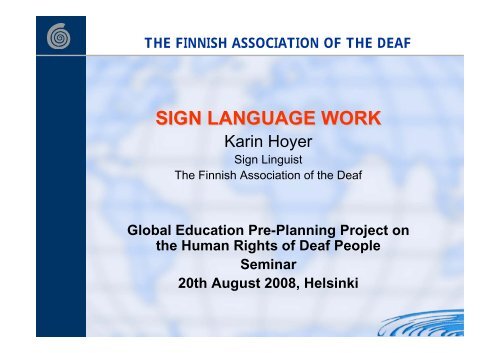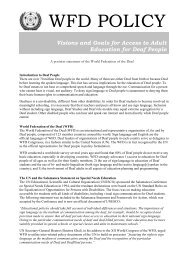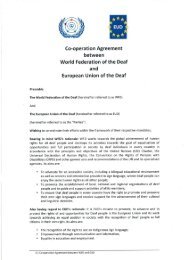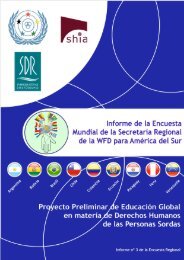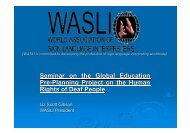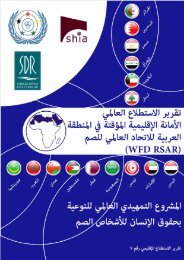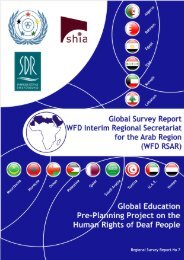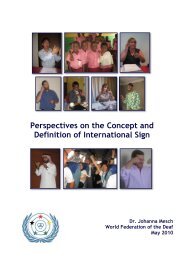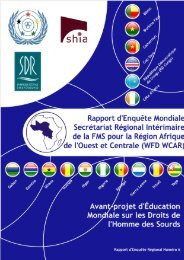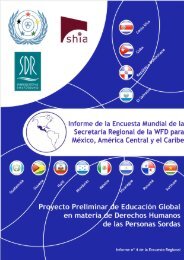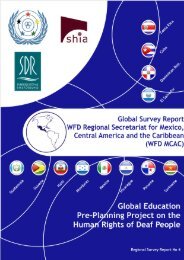SIGN LANGUAGE WORK - World Federation of the Deaf
SIGN LANGUAGE WORK - World Federation of the Deaf
SIGN LANGUAGE WORK - World Federation of the Deaf
You also want an ePaper? Increase the reach of your titles
YUMPU automatically turns print PDFs into web optimized ePapers that Google loves.
THE FINNISH ASSOCIATION OF THE DEAF<br />
<strong>SIGN</strong> <strong>LANGUAGE</strong> <strong>WORK</strong><br />
Karin Hoyer<br />
Sign Linguist<br />
The Finnish Association <strong>of</strong> <strong>the</strong> <strong>Deaf</strong><br />
Global Education Pre-Planning Project on<br />
<strong>the</strong> Human Rights <strong>of</strong> <strong>Deaf</strong> People<br />
Seminar<br />
20th August 2008, Helsinki
THE FINNISH ASSOCIATION OF THE DEAF<br />
My background:<br />
• No <strong>Deaf</strong> family background but a member <strong>of</strong> a linguistic<br />
minority. Swedish-speakers are 6 % <strong>of</strong> <strong>the</strong> population <strong>of</strong><br />
Finland<br />
• Sign language interpreter degree in 1993<br />
• MA in linguistics 1999<br />
• PhD-student in General Linguistics at University <strong>of</strong> Helsinki<br />
• 1998 – 2002 Finland-Swedish Sign Language research project<br />
• 2002 Linguistic advisor –> Sign Language Work (SLW) in<br />
Balkan (Albania and Kosovo) in two development co-operation<br />
projects funded by <strong>the</strong> Ministry for Foreign Affairs <strong>of</strong> Finland<br />
and <strong>the</strong> Finnish Association <strong>of</strong> <strong>the</strong> <strong>Deaf</strong><br />
• The Finnish Association <strong>of</strong> <strong>the</strong> <strong>Deaf</strong> (FAD)<br />
• Albanian National Association <strong>of</strong> <strong>the</strong> <strong>Deaf</strong> (ANAD)<br />
• Kosovar Association <strong>of</strong> <strong>the</strong> <strong>Deaf</strong> (KAD)
THE FINNISH ASSOCIATION OF THE DEAF
THE FINNISH ASSOCIATION OF THE DEAF<br />
The aim <strong>of</strong> this presentation:<br />
• The relationship between Sign Language<br />
Work and o<strong>the</strong>r development co-operation<br />
areas<br />
• Discuss Sign Language Work in FAD<br />
development co-operation projects on<br />
Balkan:<br />
– Methods<br />
– Challenges<br />
–Results<br />
–Ethics<br />
• To comment on <strong>the</strong> Global survey (draft)<br />
reports concerning standardisation <strong>of</strong> sign<br />
languages and dictionary work
THE FINNISH ASSOCIATION OF THE DEAF<br />
• Sign language is repressed in many countries and its<br />
use is not permitted in education. The consequence is<br />
that <strong>Deaf</strong> people are not aware <strong>of</strong> <strong>the</strong> rights <strong>the</strong>y have in<br />
society, but live as a highly marginalised group in most<br />
developing countries. There is usually no access to<br />
information for <strong>Deaf</strong> people, which means that <strong>the</strong>y do<br />
not even know what is happening in <strong>the</strong>ir immediate<br />
society and even less so in <strong>the</strong> world. Of <strong>the</strong> world's<br />
<strong>Deaf</strong> people only about five percent (5%) can read and<br />
write. This is due to <strong>the</strong> fact that <strong>Deaf</strong> people have not<br />
been educated in sign language. Improving <strong>the</strong> status<br />
<strong>of</strong> sign language has consequences for all areas <strong>of</strong> life<br />
for <strong>Deaf</strong> people, it opens up possibilities for participation,<br />
information and influence and reduction <strong>of</strong> poverty.<br />
Quotation from Colin Allen (2008: 8) Global Survey Draft Report, WFD<br />
Eastern Europe and Middle Asia Regional Secretariat
THE FINNISH ASSOCIATION OF THE DEAF<br />
Why Sign Language Work in<br />
development co-operation work?<br />
• The goals are to increase opportunities<br />
enabling <strong>Deaf</strong> people to achieve equal<br />
human rights as hearing people; and to<br />
become active participants <strong>of</strong> society;<br />
and to lead an independent life by<br />
promoting <strong>the</strong> status <strong>of</strong> <strong>the</strong> national<br />
sign languages AlbSL and KosSL.
THE FINNISH ASSOCIATION OF THE DEAF<br />
7. Priority areas for <strong>the</strong> co-operation:<br />
The WFD recommends <strong>the</strong> following to be<br />
given priority in co-operation work:<br />
• Establishment/streng<strong>the</strong>ning <strong>of</strong> an<br />
organisation <strong>of</strong> <strong>the</strong> <strong>Deaf</strong><br />
• Sign language work<br />
• Education<br />
• Income generating and vocational training<br />
• Labour market<br />
WFD POLICY_Work Done by Member Organisations in Developing<br />
Countries:
THE FINNISH ASSOCIATION OF THE DEAF<br />
The Goals and Role <strong>of</strong> <strong>the</strong> <strong>World</strong> <strong>Federation</strong> <strong>of</strong> <strong>the</strong><br />
<strong>Deaf</strong> (WFD):<br />
– To promote recognition <strong>of</strong> sign language and <strong>the</strong> right <strong>of</strong><br />
<strong>Deaf</strong> individuals to use sign language;<br />
– To promote <strong>the</strong> right <strong>of</strong> <strong>Deaf</strong> children to have early and full<br />
access to sign language;<br />
– To promote increased support for sign language research;<br />
– To promote better quality <strong>of</strong> teaching <strong>of</strong> sign language;<br />
– To promote better quality <strong>of</strong> sign language interpreting;<br />
– To promote more availability <strong>of</strong> sign language in <strong>the</strong> media.<br />
WFD Sign Language Fact Sheet<br />
THE FINNISH ASSOCIATION OF THE DEAF<br />
Colin Allen (2008): Global Survey Draft<br />
Reports:<br />
• Highest priority issues all needs Sign<br />
Language Work<br />
– Better quality <strong>of</strong> <strong>Deaf</strong> Education<br />
– Better Sign Language Interpreting quality<br />
and services<br />
– Official recognition from national<br />
Governments <strong>of</strong> <strong>the</strong>ir country’s Sign<br />
Language
THE FINNISH ASSOCIATION OF THE DEAF<br />
What is Sign Language Work?<br />
– Language documentation and basic sign language<br />
research<br />
– Application <strong>of</strong> <strong>the</strong> research results into dictionary work or<br />
o<strong>the</strong>r kind <strong>of</strong> publications, like teaching materials<br />
– Linguistic awareness training for <strong>the</strong> <strong>Deaf</strong> community<br />
– Training in sign language structure and grammar for sign<br />
language interpreter students<br />
– Training <strong>Deaf</strong> research assistants in how to teach sign<br />
language as a foreign language to hearing people.<br />
Implementing <strong>the</strong> teaching toge<strong>the</strong>r with <strong>the</strong> assistants.<br />
– Linguistic advocacy work for legal recognition <strong>of</strong> sign<br />
language and for improving existing legislation<br />
– Establishing contacts to universities and promoting<br />
research in sign language
THE FINNISH ASSOCIATION OF THE DEAF<br />
• In development support work <strong>the</strong><br />
implementation <strong>of</strong> Sign Language Work is<br />
dependant <strong>of</strong> <strong>the</strong> wider social context, <strong>the</strong><br />
country’s history, <strong>the</strong> situation with sign<br />
language, national legislation, and <strong>the</strong><br />
priorities made by <strong>the</strong> <strong>Deaf</strong> community<br />
• Important to have a sign linguist involved
THE FINNISH ASSOCIATION OF THE DEAF<br />
Why can Sign Language Work be seen as a<br />
precondition for many o<strong>the</strong>r development cooperation<br />
areas?<br />
• If you do not have research in and information about<br />
<strong>the</strong> national sign language how can you:<br />
– Train teachers <strong>of</strong> <strong>the</strong> <strong>Deaf</strong> towards improving <strong>Deaf</strong><br />
education<br />
– Train and develop a pool <strong>of</strong> high quality sign language<br />
interpreters<br />
– Teach <strong>Deaf</strong> people and improve <strong>the</strong>ir linguistic awareness<br />
– Produce materials or lobby for its legal recognition?
Advocacy<br />
work<br />
- Legislation and policies<br />
- Access to service and<br />
information<br />
- Promote <strong>the</strong> use <strong>of</strong><br />
sign language in<br />
media<br />
Interpreter<br />
Training<br />
-Tranining for students<br />
in SL and SL grammar<br />
- Programmes for <strong>Deaf</strong> to<br />
become SL interpreters and<br />
translators<br />
Sign<br />
Language<br />
Work<br />
<strong>Deaf</strong> Education<br />
- (Sign language)<br />
training programmes<br />
for teachers and<br />
teacher students<br />
- Planning, implementing<br />
and evaluation <strong>of</strong><br />
education programmes<br />
and curricula<br />
Organisational<br />
development<br />
work<br />
- Linguistic Awareness<br />
Training for <strong>the</strong> <strong>Deaf</strong><br />
community<br />
FAD; Hoyer & Lahtinen, 2007
THE FINNISH ASSOCIATION OF THE DEAF<br />
Methods in Sign Language Work:<br />
• Balkan Sign Language Work is implemented by <strong>Deaf</strong> research<br />
assistants + working group with representatives from <strong>the</strong> whole<br />
<strong>Deaf</strong> community<br />
• Precondition for success is to recruit <strong>Deaf</strong> persons with good<br />
potential (learning abilities and good signing skills) as research<br />
assistants<br />
• The relation between TRAINING and RESEARCH<br />
• Learning by doing. Basic vocabulary research done by <strong>the</strong> sign<br />
language research assistants<br />
• Interactive teaching methods, mistakes allowed. Learn by<br />
practice and by teaching o<strong>the</strong>rs (working group members)<br />
• Concrete visual tools (sign cards, prints, and drawings on <strong>the</strong><br />
wall)
THE FINNISH ASSOCIATION OF THE DEAF<br />
• <strong>Deaf</strong> community commitment crucial. <strong>Deaf</strong><br />
community shall feel ownership towards <strong>the</strong> work<br />
• Linguistic advisor present 2-6 weeks 3 times/ one<br />
year/ each project<br />
• Important that <strong>the</strong> linguistic skills are transferred to<br />
<strong>the</strong> <strong>Deaf</strong> assistants and <strong>the</strong> working group members<br />
for <strong>the</strong> work not to collapse when no advisor is<br />
present<br />
• Relationship between foreign advisor – local<br />
research assistants and working group members<br />
• Keys to successful work:<br />
– Communication in <strong>the</strong> local sign language<br />
– Advisor should be aware <strong>of</strong> her/his own language
THE FINNISH ASSOCIATION OF THE DEAF<br />
3. Development <strong>of</strong> Co-operation between <strong>Deaf</strong> associations in<br />
Developing and Developed Countries<br />
• The WFD will work towards a situation whereby:<br />
• A. <strong>Deaf</strong> Associations in developed countries are encouraged to enter<br />
into a partnership/co-operation with counterparts in <strong>the</strong> south.<br />
• B. The co-operation should as much as possible be based on <strong>the</strong><br />
principle <strong>of</strong> mutual respect for cultural, language and social economic<br />
realities, e.g. in sign language work. The objective should not be to<br />
export <strong>the</strong> sign language <strong>of</strong> <strong>the</strong> developed countries, but for<br />
developing countries to research and/or develop <strong>the</strong>ir own sign<br />
languages based on cultural realities.<br />
• C. <strong>Deaf</strong> people from developing countries should be encouraged to<br />
receive training in specific areas (e.g. sign language and<br />
management) in developed countries. However, <strong>the</strong> training should be<br />
tailored to enable <strong>the</strong>m to work with <strong>the</strong> languages in <strong>the</strong>ir own<br />
countries.<br />
WFD POLICY_WFD Work in Developing countries<br />
THE FINNISH ASSOCIATION OF THE DEAF<br />
• Colin Allen (2008: 18) Global Survey Draft Report,<br />
WFD Interim Regional Secretariat for Western and<br />
Central Africa:<br />
• Six countries (Benin, Cape Verde, Chad, Senegal,<br />
Sierra Leone and Togo) do not lobby for recognition<br />
<strong>of</strong> <strong>the</strong>ir sign language due to:<br />
– Political conflict in <strong>the</strong> country;<br />
– Sign language does not exist in <strong>the</strong> country;<br />
– American Sign Language is accepted and not opposed to<br />
by <strong>the</strong> authorities;<br />
– Philosophical conflicts about sign language within <strong>the</strong> <strong>Deaf</strong><br />
Community; and<br />
– The national sign language does not have <strong>of</strong>ficial status but<br />
American Sign Language is used, using French concepts.
THE FINNISH ASSOCIATION OF THE DEAF<br />
Keys to successful work (continue):<br />
• Mutual respect, Flexibility, cultural sensitivity<br />
• Language policy in <strong>the</strong> <strong>of</strong>fice concerning <strong>the</strong> use <strong>of</strong><br />
sign language. Advisor role model for hearing<br />
people<br />
• A conscious approach to use only <strong>Deaf</strong> language<br />
users in <strong>the</strong> documentation work for dictionary work<br />
• To avoid <strong>the</strong> influence from hearing non-signers<br />
• To promote <strong>the</strong> self-esteem <strong>of</strong> <strong>the</strong> <strong>Deaf</strong> community
THE FINNISH ASSOCIATION OF THE DEAF<br />
• Research method: documentation <strong>of</strong> real language<br />
use – word lists not in use<br />
• Never 1:1 correspondence between signs and<br />
words<br />
• “thumbs up” – good, fine, nice, well, bravo!, ok<br />
• Visual dictionaries (VHS, dvd or Internet) for <strong>the</strong><br />
publication to show how <strong>the</strong> sign language actually<br />
look and move<br />
• Sign language is as adequate as a spoken language<br />
– Video reports in sign language<br />
– No written language in common for<br />
communication on distance – Fast Internet
THE FINNISH ASSOCIATION OF THE DEAF<br />
• Tools for depicting <strong>the</strong> documented signs<br />
• Drawing from <strong>the</strong> TV or computer screen<br />
• On <strong>the</strong> Internet <strong>the</strong>re is free downloadable programmes for<br />
depicting signs with computer<br />
– VirtualDub for video capturing<br />
– The graphics editor programmes GIMP and Incscape<br />
– Lay-out programme Scribus<br />
• Important to see both <strong>the</strong> ”big picture” <strong>of</strong> dictionary work as <strong>the</strong><br />
individual parts in <strong>the</strong> process<br />
• Successful work needs good planning!<br />
• Sign language processes are based on local co-operation (e.g.<br />
dictionary work, or lobbying for recognition <strong>of</strong> Sign language in<br />
<strong>the</strong> legislation)<br />
• The work needs involvement <strong>of</strong> O = organisational work<br />
towards <strong>the</strong> <strong>Deaf</strong> community, SLW, A= advocacy work, and<br />
INT= interpreters
DICTIONARY<br />
Editing video/<br />
dvd interface<br />
SLW ?<br />
Work<br />
with spoken language<br />
equivalents<br />
SLW<br />
INT<br />
Information<br />
<strong>Deaf</strong> community<br />
Hearing network<br />
Book<br />
preface, index, layout<br />
printing<br />
SLW<br />
SLW INT<br />
?<br />
Translation <strong>of</strong><br />
sentences into<br />
spoken language<br />
SL Working group<br />
Videotape<br />
discussion on signs,<br />
signs and sentences<br />
<strong>the</strong>ir form and use<br />
SLW O SLW O<br />
Lobby University<br />
SL research<br />
-> SL gets<br />
document SL use<br />
linguistic status<br />
SLW O SLW O/A INT<br />
INT<br />
FAD; Hoyer & Lahtinen, 2007
RECOGNITION OF<br />
NATIONAL <strong>SIGN</strong> <strong>LANGUAGE</strong> IN LEGISLATION<br />
<strong>Deaf</strong> give training<br />
to <strong>Deaf</strong> community<br />
-> tools for lobbying<br />
to hearing network<br />
SLW O/A INT<br />
Applied research<br />
dictionaries,<br />
information material<br />
SLW O INT<br />
Advocacy and lobbying<br />
<strong>Deaf</strong> community members lobby locally,<br />
<strong>Deaf</strong> organisation lobby government<br />
-> change in legislation<br />
SLW O/A INT<br />
Advisors train <strong>Deaf</strong> trainers<br />
Linguistic rights, SL grammar<br />
legislation structure, pedagogy<br />
SLW O/A<br />
INT<br />
Lobby University<br />
-> SL gets<br />
SL research<br />
linguistic status<br />
document SL<br />
SLW O SLW O/A INT<br />
FAD; Hoyer & Lahtinen, 2007
THE FINNISH ASSOCIATION OF THE DEAF<br />
Challenges in Sign Language Work:<br />
• Realistic planning!!<br />
• Time management<br />
– 3 years is a short time for Sign Language Work<br />
– Learning totally new concepts takes time<br />
– There is a limit to what you can learn at one time<br />
• Balance between focusing on sign level (=dictionary work) and<br />
grammar <strong>of</strong> sign language, since one <strong>of</strong> <strong>the</strong> most common<br />
misconceptions about sign languages is that <strong>the</strong> signs are<br />
articulated according to <strong>the</strong> word order <strong>of</strong> <strong>the</strong> surrounding<br />
spoken language<br />
• Cultural differences<br />
• How to commit <strong>the</strong> working group members to a long-term<br />
work on voluntary basis
THE FINNISH ASSOCIATION OF THE DEAF<br />
Results in or as a consequence <strong>of</strong> Sign Language<br />
Work:<br />
• Overt:<br />
– Dictionaries, o<strong>the</strong>r materials about, and in, sign language<br />
– In Albania: National news bulletin translated into AlbSL by<br />
<strong>Deaf</strong> translators<br />
• Covert:<br />
– Skills in sign linguistics<br />
– Risen linguistic awareness (<strong>Deaf</strong>, family members,<br />
interpreters, teachers, hearing network)<br />
– Sign language skills (teachers, interpreters)
THE FINNISH ASSOCIATION OF THE DEAF<br />
Ethics in Sign Language Work:<br />
• Consent for video filming<br />
• Research methods<br />
– Democratic and transparent<br />
– Community based – gender, age and<br />
regional balance
THE FINNISH ASSOCIATION OF THE DEAF<br />
• Quotation from Evaluation Report (2008) <strong>of</strong> FAD<br />
project in Kosovo for <strong>the</strong> successes <strong>of</strong> SLW:<br />
8.1.2. Effective <strong>Deaf</strong> community<br />
involvement/ownership<br />
• A previous exercise to develop a book <strong>of</strong> Kosovar<br />
Signs in 2002 met with great resistance, antagonism<br />
and rejection from many members <strong>of</strong> <strong>the</strong> <strong>Deaf</strong><br />
community. (This work had been led by individuals<br />
with no training in sign linguistics and is regarded as<br />
unscientific) To ensure consensus on <strong>the</strong> work <strong>of</strong><br />
<strong>the</strong> present sign language research team, <strong>the</strong><br />
volunteer working group, from different geographical<br />
and social backgrounds and <strong>of</strong> varying ages and<br />
gender will collectively be responsible for producing<br />
<strong>the</strong> DVD and booklet in 2009.
THE FINNISH ASSOCIATION OF THE DEAF<br />
The external evaluator observed a training session for two <strong>of</strong> <strong>the</strong> <strong>Deaf</strong><br />
working group volunteers and was impressed by <strong>the</strong> careful<br />
explanations <strong>of</strong> <strong>the</strong> need for ethical consistency, consent and<br />
technical information. It is commendable to see that this group <strong>of</strong><br />
volunteers demonstrates considerable commitment, <strong>of</strong>ten having to<br />
travel long and difficult distances to attend training meetings.<br />
The Working Group is also active in disseminating information about <strong>the</strong><br />
sign language work to o<strong>the</strong>r members <strong>of</strong> <strong>the</strong> <strong>Deaf</strong> community:<br />
‘I was always told by hearing people that I couldn’t do things – that <strong>the</strong>y<br />
were smarter. Now I understand that it is a language issue’<br />
‘Knowing it is a real language gives me confidence’<br />
This has had an impact on <strong>the</strong> self-esteem <strong>of</strong> <strong>Deaf</strong> people in Kosovo.<br />
Said one hearing observer:<br />
‘We never saw people signing before <strong>the</strong> War – now <strong>the</strong>y are confident to<br />
use it. (Sign language)’
THE FINNISH ASSOCIATION OF THE DEAF<br />
Language planning and language standardization<br />
work for sign languages:<br />
• Colin Allen (2008: 23) Global Survey Draft Report, WFD Regional<br />
Secretariat for Asia and <strong>the</strong> Pacific:<br />
• Common areas <strong>of</strong> concern: ---<br />
Sign Language<br />
• <strong>Deaf</strong> people have no sign language skills.<br />
• Government does not recognise <strong>the</strong> sign language.<br />
• Sign language materials and courses should be provided for<br />
<strong>Deaf</strong> people who have not learned <strong>the</strong>ir own language.<br />
• The promotion <strong>of</strong> Human Rights through Sign Languages<br />
needs to be streng<strong>the</strong>ned.<br />
• Need to standardise <strong>the</strong> national sign language.
THE FINNISH ASSOCIATION OF THE DEAF<br />
• Colin Allen (2008: 22) Global Survey Draft Report,<br />
WFD Interim Regional Secretariat for Western and<br />
Central Africa<br />
• Common areas <strong>of</strong> concern: ---<br />
Sign Language<br />
• Government does not recognise <strong>the</strong><br />
sign language.<br />
• Standardised sign language.
THE FINNISH ASSOCIATION OF THE DEAF<br />
• Unification – Standardization<br />
• see WFD POLICY_ WFD Statement on <strong>the</strong> Unification<br />
<strong>of</strong> Sign Languages<br />
)<br />
• WFD opposes all attempts to unify several sign<br />
languages to a single sign language<br />
• WFD also opposes purification <strong>of</strong> <strong>the</strong> language from<br />
outside <strong>the</strong> community – it is a natural process that<br />
languages change over time and that new signs gets<br />
adopted into <strong>the</strong> languages<br />
• “The control <strong>of</strong> <strong>the</strong> development <strong>of</strong> any Sign Language<br />
must be left to any social group where <strong>the</strong> particular<br />
Sign Language is exercised.”
THE FINNISH ASSOCIATION OF THE DEAF<br />
• Native sign language users use different form <strong>of</strong><br />
language in different situations<br />
• Compare e.g. <strong>the</strong> language used in private<br />
conversations to <strong>the</strong> language used in seminar<br />
presentations<br />
When is a standard variety <strong>of</strong> sign language used?<br />
• Public, “<strong>of</strong>ficial” purposes, like TV news,<br />
Government information on <strong>the</strong> web<br />
• When producing teaching materials <strong>the</strong>re might be<br />
an conscious effort to use a standard variety<br />
• In dictionary work <strong>the</strong> aim might be to describe<br />
standard language instead <strong>of</strong> regional dialects
THE FINNISH ASSOCIATION OF THE DEAF<br />
• Standardization work is usually associated with writing and<br />
literacy – <strong>the</strong> “right” way to write <strong>the</strong> language according to<br />
grammars and dictionaries<br />
• Signed languages are <strong>of</strong>ten compared to written languages<br />
that are more standardized than spoken languages<br />
• It is within <strong>the</strong> nature <strong>of</strong> a language that does not have a<br />
written form to have a big amount <strong>of</strong> variation<br />
• Making a dictionary is standardization work in <strong>the</strong> way that not<br />
all <strong>the</strong> signs <strong>of</strong> <strong>the</strong> language is included in <strong>the</strong> dictionary<br />
• The chosen sign might in <strong>the</strong> future be considered more “right”<br />
than o<strong>the</strong>r signs, since <strong>the</strong>y are recorded in <strong>the</strong> dictionary<br />
• The dictionary makers <strong>of</strong> AlbSL wanted to show variation in <strong>the</strong><br />
language by including variants <strong>of</strong> <strong>the</strong> same concept (see e.g.<br />
signs 34, 35, 37, 38 for ‘bro<strong>the</strong>r’). The AlbSL dictionary was<br />
descriptive and not prescriptive
THE FINNISH ASSOCIATION OF THE DEAF<br />
• “Need to standardize <strong>the</strong> national sign language.” Whose<br />
need?<br />
• A standard variety <strong>of</strong> a language is usually promoted in<br />
education and in <strong>the</strong> media. Existence <strong>of</strong> a standard form might<br />
be used as a condition for <strong>of</strong>ficial recognition <strong>of</strong> <strong>the</strong> language<br />
or for its use as a language <strong>of</strong> instruction<br />
• It seems that <strong>the</strong> impetus to standardize sign languages<br />
usually come from <strong>the</strong> desire <strong>of</strong> hearing persons, not <strong>Deaf</strong><br />
persons, e.g. in <strong>the</strong>ir learning process.<br />
• Teachers and interpreters might think that <strong>the</strong>re should only be<br />
one sign for each word. This opinion reveals ignorance about<br />
sign languages<br />
• The standardization desire is focused on individual signs<br />
• Usually <strong>Deaf</strong> signers have no problem understanding each<br />
o<strong>the</strong>r, even if <strong>the</strong>y use different signs.
THE FINNISH ASSOCIATION OF THE DEAF<br />
• There is never a one-to-one relationship between<br />
languages. A word can have many sign equivalents<br />
and a sign can have many word equivalents<br />
• Each language is tied to a specific culture, sign<br />
languages reflect <strong>Deaf</strong> culture. There is a lot <strong>of</strong><br />
signs that do not have an one word equivalent, but<br />
must be translated by using a longer expression<br />
• The decision <strong>of</strong> whe<strong>the</strong>r to standardize a sign<br />
language or not, is to be made by <strong>the</strong> language<br />
users <strong>the</strong>mselves<br />
• Variation is a natural part <strong>of</strong> language
THE FINNISH ASSOCIATION OF THE DEAF<br />
• Questionnaire question: 7.7.2 Does your country<br />
have a sign language dictionary?<br />
• Why is a dictionary important?<br />
– For giving status to <strong>the</strong> language – it exists -> you can get<br />
legal recognition <strong>of</strong> <strong>the</strong> language.<br />
• Ulrike Mosel (2006: 68): In community language<br />
work among indigenous people <strong>of</strong> spoken<br />
languages a dictionary ranks highest on <strong>the</strong>ir list <strong>of</strong><br />
priorities<br />
• SL dictionaries:<br />
– Who have been involved compiling it?<br />
– Does it give a fair picture <strong>of</strong> <strong>the</strong> SL?<br />
– How is <strong>the</strong> visual language presented? In still drawings or<br />
pictures? In live form?<br />
– Who is it made for?
THE FINNISH ASSOCIATION OF THE DEAF<br />
• Wishes for <strong>the</strong> future for developing Sign<br />
Language Work:<br />
• Language Policy Programme (WFD Statement on<br />
<strong>the</strong> Unification <strong>of</strong> Sign Languages – Good!)<br />
• Handbook on Sign Language Work with guidelines,<br />
for not everybody to having to re-invent <strong>the</strong> wheel
THE FINNISH ASSOCIATION OF THE DEAF<br />
• That burning urge to find out formed <strong>the</strong> basis <strong>of</strong> my first<br />
interest in Sign Language. As I read and asked questions<br />
about <strong>the</strong> language, I came to realize that <strong>the</strong> <strong>Deaf</strong> were<br />
perhaps <strong>the</strong> most misunderstood language minority anywhere<br />
in <strong>the</strong> world. This realization changed my interest from mere<br />
curiosity to a sense <strong>of</strong> mission. Hearing people <strong>of</strong>ten talk about<br />
<strong>the</strong> rehabilitation <strong>of</strong> <strong>the</strong> <strong>Deaf</strong>. Now, it seems to me, what one<br />
ought to talk about is not <strong>the</strong> rehabilitation, but <strong>the</strong> liberation <strong>of</strong><br />
<strong>the</strong> <strong>Deaf</strong>.<br />
• I believe <strong>the</strong> science <strong>of</strong> linguistics has a significant role to play<br />
in that liberation struggle.<br />
• Okoth Okombo (1990: 59)
THE FINNISH ASSOCIATION OF THE DEAF<br />
Some references:<br />
• Allen, Colin (2008) Global Survey Draft Report, WFD Eastern Europe and<br />
Middle Asia Regional Secretariat<br />
• Allen, Colin (2008) Global Survey Draft Report, WFD Interim Regional<br />
Secretariat for Western and Central Africa<br />
• Allen, Colin (2008) Global Survey Draft Report, WFD Regional Secretariat for<br />
Asia and <strong>the</strong> Pacific<br />
• Dotter, Franz, 'S<strong>of</strong>t' standardization <strong>of</strong> sign languages?<br />
• Gibson, Liz Scott & Nexhat Shatri (2008) Report from <strong>the</strong> Evaluation <strong>of</strong> <strong>the</strong><br />
Organisational Training and Sign Language Development Projects in Kosovo.<br />
• Mosel, Ulrike (2006). Fieldwork and community language work. In Essentials <strong>of</strong><br />
Language Documentation, edited by Gippert, Himmelmann & Mosel<br />
• Okombo, Okoth (1990) Linguistics and <strong>the</strong> Liberation <strong>of</strong> <strong>the</strong> Kenyan <strong>Deaf</strong>:<br />
Some Research Agenda for Sign Language Developers. In East African Sign<br />
Language Seminar 20–26.8.1990 Report<br />
• WFD Sign Language Fact Sheet<br />
<br />
• WFD POLICY_WFD Work in Developing countries<br />
<br />
• WFD POLICY _Work Done by Member Organisations in Developing Countries<br />
<br />
• WFD POLICY_ WFD Statement on <strong>the</strong> Unification <strong>of</strong> Sign Languages<br />


